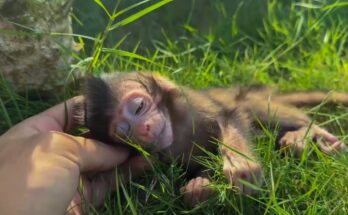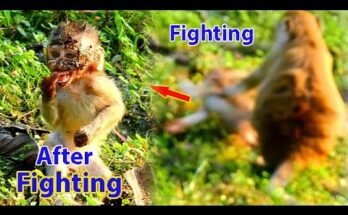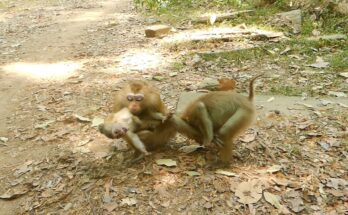Baby Daniela’s world has narrowed to a few shaky branches and a thudding heartbeat. The forest around her is loud—wings, leaves, and the distant chatter of a troop—but her tiny body is still. She flinches at every sudden movement, scanning for help, unsure where it will come from. Nearby, Dee Dee looms—bigger, stronger, and unpredictably rough. Whatever the history between them, today the imbalance is clear: Daniela is too small to defend herself, too young to understand the danger, and running out of safe places to hide.
This video follows a delicate, time-critical effort to bring Daniela to safety. You’ll see how the first responders assess her condition from a distance—watching her breathing, the set of her shoulders, the way she clings to the bark. Every second matters. Approaching too fast could scatter the troop and push Daniela into deeper risk; approaching too slow could mean missing the chance to prevent a serious injury. The team coordinates quietly, signaling positions, preparing soft capture gear, and creating a safe corridor so Daniela has somewhere secure to retreat.
We focus on compassion and careful handling. The rescuers speak in low, steady tones, avoiding sudden gestures. When Daniela finally accepts a moment of calm, you’ll witness the gentlest lift, the careful check for bruising, and the quick scan for dehydration or shock. No dramatics—just experienced hands and a plan designed around Daniela’s needs. The goal is simple: stabilize, comfort, and reunite her with safety, whether that means returning her to a protected spot with supportive adults or transporting her to a qualified wildlife team for short-term care.
Dee Dee’s presence is part of the challenge. Rather than demonizing, the rescue shows what responsible intervention looks like: redirecting behavior, creating space, and prioritizing the youngest and most vulnerable without escalating conflict. It’s a lesson in reading body language, respecting troop dynamics, and stepping in only when welfare is clearly at risk.
By the end, Daniela’s tiny fingers relax. Her breathing evens out. You’ll see the small but significant signs of recovery—a blink that lingers a little longer, a shoulder that unclenches, a curious glance toward the humans who chose care over chaos. The last shots emphasize what this channel stands for: ethical response, professional guidance, and hope rooted in action.
If you witness wildlife in distress, please contact local authorities or licensed rescue organizations rather than attempting solo intervention. Share this video to raise awareness about humane rescue practices, and consider supporting the groups who make this work possible. Baby Daniela’s story is a reminder that compassion—applied with skill and patience—can change the outcome for those who can’t ask for help themselves.


